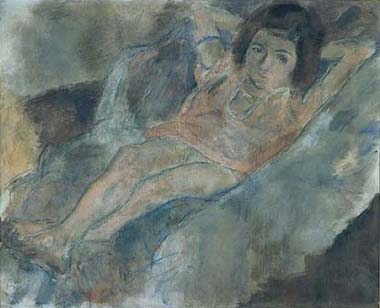February 1 (Sat.)–May 11 (Sun.), 2014
In the Collection 4 exhibit, we take a look back at 100 years of trends in Western art that preceded the emergence of contemporary art.
As is evident from today's Japanese art, Western art set the world standard during the second half of the 19th century. Though the influence of colonialism cannot be completely discounted, Western learning and culture were not always forcibly imposed on other regions. In some cases, interest in these things developed in a semi-spontaneous manner while fusing with each country's traditional culture.
In the first part of this exhibit, we introduce a group of the artists who were active in Paris, then known as the "capital of art." At the beginning of the 20th century, many young Japanese moved to France in order to study art. While living in Paris, artists like Saeki Yuzo and Fujita Tsuguharu, developed lively creative practices. On the other hand, there were artists like Kuniyoshi Yasuo, a painter who spent his life in New York, who moved to Paris for a time in the 1920s and fell under the influence of Jules Pascin.
In the second part, we trace developments in European art following World War II. After the war, there was a rapid increase of creative styles. This is also evident from the expansion and changes of artistic concepts during the era.
This in turn led to the conspicuous rise of American art. In the third part, we present a varied lineup of contemporary American art that began to flourish in the 1950s. Coinciding with various economic developments, American art, which swept the art world with a succession of trends beginning with Abstract Expressionism and continuing with Pop Art and Minimal Art, offers an alluring variety of creative expressions.
In the fourth section, we focus on photography, which is now seen as part of contemporary art. Here we see a new visual world, characterized by its fictional aspects and increasing size, that is unlike art photography of the past.
In the last section, we turn our attention to the current state of art, from the late 20th to the early 21st century. Here we consider how our own era is being perceived and expressed while comparing the works on display to art of the past.
1. Artists Who Flocked to Paris
2. The New Wave of Postwar Art
3. The American Art Revolution
4. The Development of Photography as Contemporary Art
5. Art Now: Focus on Europe

Jules Pascin, Jeune fille à la chemise rose (Fillette au bracelet bleu),
1924-25, The National Museum of Art, Osaka
Opening Hours
10:00–17:00, Fridays until 19:00
Admission until 30 minutes before closing
Closed
Mondays *except April 28 and May 5
Admission Fee
■February 1 (Sat.)–March 30 (Sun.), 2014
Adults : 420 Yen (210 Yen)
University students : 130 Yen (70 Yen)
■April 1 (Tue.)–May 11 (Sun.), 2014
Adults : 430 Yen (220 Yen)
University students : 130 Yen (70 Yen)